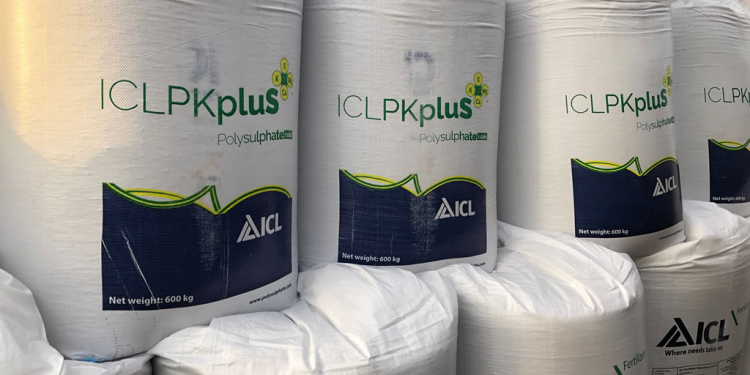Polysulphate research from Dr. Carl Rosen shows an increase in total AND marketable yields when compared to grower standard practice

Despite its vital role in optimum crop performance, sulfur has not always received the attention it deserves, often overshadowed by more popular and well-known yield boosting nutrients, nitrogen, phosphorus, and potassium. For years, sulfur deficiency wasn’t a top concern for most potato growers. In the past, mineralized organic matter and high sulfur emissions supplied more than enough to meet crop needs. Over the last 30 years, with the introduction of the Clean Air Act, sulfur emissions have substantially reduced atmospheric sulfur availability in North America. The fact is, alongside N, P, and K, sulfur is a powerhouse nutrient, and a limiting factor in crop yield and quality. So, where does that leave today’s grower?
Sulfur can have a significant influence on both tuber quality and quantity. Despite potato’s comparatively low sulfur demand compared to oilseeds or brassicas, our understanding of soil fertility has evolved, along with our understanding of why sulfur can directly impact ROI.
Does Sulfur Matter for Potatoes?
Sulfur is an essential building block for proteins. Required for amino acid synthesis and necessary for high nitrogen use efficiency, sulfur can impact tuber development, carbohydrate generation, disease resistance, and chlorophyll production. Research suggests that specific gravity, dry matter, sugar and starch content, and tuber size are all significantly influenced by sulfur.

Since a sulfur deficiency, at any stage, can result in reduced yields, a continuous supply of sulfur—from emergence to maturity—is required for a healthy and profitable crop. It is important for crops to be able to access the sulfur they need, when they need it most.
Polysulphate (0-0-14-19.2S-12.2Ca-3.6Mg) is derived from polyhalite (a naturally occurring mineral mined exclusively by ICL). This multi-nutrient fertilizer is a low-chloride sulfate-based source of soluble potassium, magnesium and calcium.
The prolonged-release characteristic of Polysulphate means that the four essential nutrients (S 19.2%, K 14%, Mg 3.6%, Ca 12.2%) contained in every granule will be available to the potatoes during periods of peak demand, from vegetative growth to tuber maturation—playing an important role in both yield and quality.
The calcium in fertilizer influences soil chemistry as well as potato tuber quality attributes. In soil types or in irrigated cropping systems where water quality can be a challenge, the addition of calcium to the soil can contribute to remediation of accumulated salts. With very low chloride, low salinity index, neutral pH, and no liming effect, research has proven results across a variety of soil types, making Polysulphate a flexible crop nutrition solution. Applied as a pre-plant, at planting or during hilling, Polysulphate can also be blended with SOP or MOP for an added source of quick-release K. We recommend speaking with your agronomist or consulting with someone on our team to learn more about application rates and best practice guidelines.
As part of a sustainable sulfur solution that minimizes inputs and maximizes ROI, Polysulphate is an innovative choice for today’s growers. ICL is proud to offer Polysulphate to a growing network of dealers and retailers as part of their progressive plant nutrition portfolios (more: icl-sf.com/us-en ).
There are three main types of sulphur fertilizer.
- Sulphate-sulphur fertilizers contain sulphur in combination with other nutrients, such as nitrogen or potassium. Fertilizer is readily available to growing crops and sulphate-sulphur fertilizers dissolve quickly. The most common sulphate-sulphur fertilizer sold in Saskatchewan is granular ammonium sulphate (20-0-0-24, 21-0-0-24, 19-2-0-22).
- Ammonium sulphate can be blended with other granular fertilizers, but care should be taken to ensure the physical nature of the ammonium sulphate will allow the blend to remain uniform.
- Potassium sulphate (0-0-50-18 and other formulations) is also available and is well suited to legume crops such as alfalfa, where both potassium and sulphur are needed but not nitrogen.
There are other fertilizer products containing some sulphate-sulphur, either in a blend or in a manufactured product.
Elemental sulphur is not immediately effective for soils very deficient in sulphur, but may be a useful part of a long-term sulphur fertilizer management plan for soils low in plant-available sulphur.
- Elemental sulphur fertilizers (0-0-0-90 to 99) are granular, with 90 to 99 per cent sulphur in the elemental form. Elemental sulphur cannot be directly used by plants. It must first be converted to sulphate-sulphur (SO4-2 -S) by soil microorganisms.
Fertilizers containing sulphur as thiosulphate, such as liquid ammonium thiosulphate (12-0-0-26) and 15-0-0-20 must also be oxidized by microbes in the soil to the sulphate form. However, the oxidation is rapid and recommended rates of ammonium thiosulphate can be applied the year sulphate-sulphur is required. Fertilizer can be applied before, during or after seeding. However, when applied as foliar or dribble band to a crop, direct contact with plant leaves may cause leaf scorching. Follow manufacturers’ instructions for blending.
Animal manure can provide sulphur along with other plant nutrients, but the sulphur content and balance with other nutrients is variable and should be determined through manure analysis along with soil testing to determine relative requirements. For example, some liquid swine manures have low contents of available sulphur relative to nitrogen, and crop responses to supplemental sulphur fertilizer have been observed on manured soils in field trials where sulphur deficiencies exist.
Applying high rates of sulphur fertilizers to lower pH of the soil is not highly effective. This practice is usually done to try to make iron, zinc or other nutrients more available to some horticulture crops. Additions of high amounts of sulphur fertilizers can also increase the amount of soluble salts (sulphates) in the soil causing the salinity levels to increase. The increase in soil salinity can reduce yields of sensitive crops.









